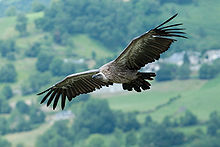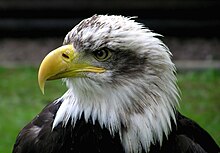Many species of birds may be considered partly or exclusively predatory. However, in ornithology, the term "bird of prey" applies only to birds of the families listed below. Taken literally, the term "bird of prey" has a wide meaning that includes many birds that hunt and feed on animals and also birds that eat very small insects.[2] In ornithology, the definition for "bird of prey" has a narrower meaning: birds that have very good eyesight for finding food, strong feet for holding food, and a strong curved beak for tearing flesh.[3] Most birds of prey also have strong curved talons for catching or killing prey.[3][4] An example of this difference in definition, the narrower definition excludes storks and gulls, which can eat quite large fish, partly because these birds catch and kill prey entirely with their beaks,[2] and similarly bird-eating skuas, fish-eating penguins, and vertebrate-eating kookaburras are excluded. Birds of prey generally prey on vertebrates, which are usually quite large relative to the size of the bird.[2] Most also eat carrion, at least occasionally, and vultures and condors eat carrion as their main food source.[3] Many raptor species are considered apex predators.

Classification by ancestry
The diurnal birds of prey are formally classified into five families.- Accipitridae: hawks, eagles, buzzards, harriers, kites and Old World vultures
- Pandionidae: the osprey
- Sagittariidae: the secretary bird
- Falconidae: falcons, caracaras and forest falcons
- Cathartidae: New World vultures
The secretary bird and/or osprey are sometimes listed as subfamilies of Acciptridae: Sagittariinae and Pandioninae respectively.
The nocturnal birds of prey – the owls – are classified separately as members of two extant families of the order Strigiformes:
Historical classifications
The taxonomy of Carl Linnaeus grouped birds (class Aves) into orders, genera and species, with no formal ranks between genus and order. He placed all birds of prey into a single order, Accipitres, subdividing this into four genera: Vultur (vultures), Falco (eagles, hawks, falcons, etc.), Strix (owls), and Lanius (shrikes). This approach was followed by subsequent authors such as Gmelin, Latham, and Turnton.Louis Pierre Veillot used additional ranks: order, tribe, family, genus, species. Birds of prey (order Accipitres) were divided into diurnal and nocturnal tribes; the owls remained monogeneric (family Ægolii, genus Strix), whilst the diurnal raptors were divided into three families: Vulturini, Gypaëti, and Accipitrini.[5]
Thus Veillot's families were similar to the Linnaean genera, with the difference that shrikes were no longer included amongst the birds of prey. In addition to the original Vultur and Falco (now reduced in scope), Veillot adopted four genera from Savigny: Phene, Haliæetus, Pandion, and Elanus. He also introduced five new genera of vultures (Gypagus, Catharista, Daptrius, Ibycter, Polyborus)[note 1] and eleven new genera of accipitrines (Aquila, Circaëtus, Circus, Buteo, Milvus, Ictinia, Physeta, Harpia, Spizaëtus, Asturina, Sparvius).
Common names
The common names for various birds of prey are based on structure, but many of the traditional names do not reflect the evolutionary relationships between the groups.- Eagles tend to be large birds with long, broad wings and massive feet. Booted eagles have legs and feet feathered to the toes and build very large stick nests.
- Ospreys, a single species found worldwide that specializes in catching fish and builds large stick nests.
- Kites have long wings and relatively weak legs. They spend much of their time soaring. They will take live vertebrate prey, but mostly feed on insects or even carrion.
- The true hawks are medium-sized birds of prey that usually belong to the genus Accipiter (see below). They are mainly woodland birds that hunt by sudden dashes from a concealed perch. They usually have long tails for tight steering.
- Buzzards are medium-large raptors with robust bodies and broad wings, or, alternatively, any bird of the genus Buteo (also commonly known as "hawks" in North America).
- Harriers are large, slender hawk-like birds with long tails and long thin legs. Most use a combination of keen eyesight and hearing to hunt small vertebrates, gliding on their long broad wings and circling low over grasslands and marshes.
- Vultures are carrion-eating raptors of two distinct biological families: the Accipitridae, which only occurs in the Eastern Hemisphere; and the Cathartidae, which only occurs in the Western Hemisphere. Members of both groups have heads either partly or fully devoid of feathers.
- Falcons are medium-size birds of prey with long pointy wings. Unlike most other raptors, they belong to the Falconidae, rather than the Accipitridae. Many are particularly swift flyers. Caracaras are a distinct subgroup of the Falconidae unique to the New World, and most common in the Neotropics – their broad wings, naked faces and appetites of a generalist suggest some level of convergence with either the Buteos or the vulturine birds, or both.
- Owls are variable-sized, typically night-specialized hunting birds. They fly almost silently due to their special feather structure that reduces turbulence. They have particularly acute hearing.
Some names have not generalized, and refer to single species (or groups of closely-related (sub)species): merlin (Falco columbarius), osprey (Pandion haliaetus).






No comments:
Post a Comment
Note: Only a member of this blog may post a comment.